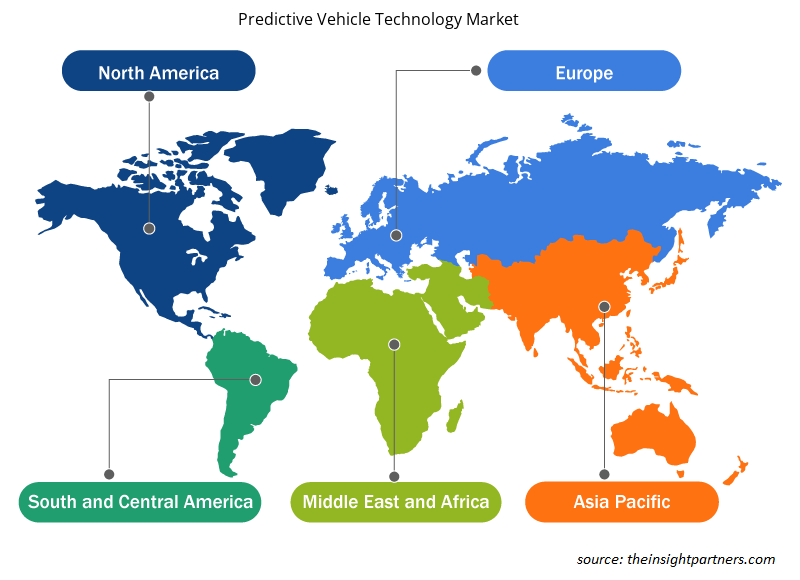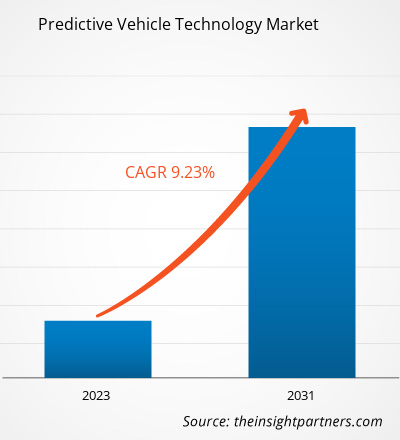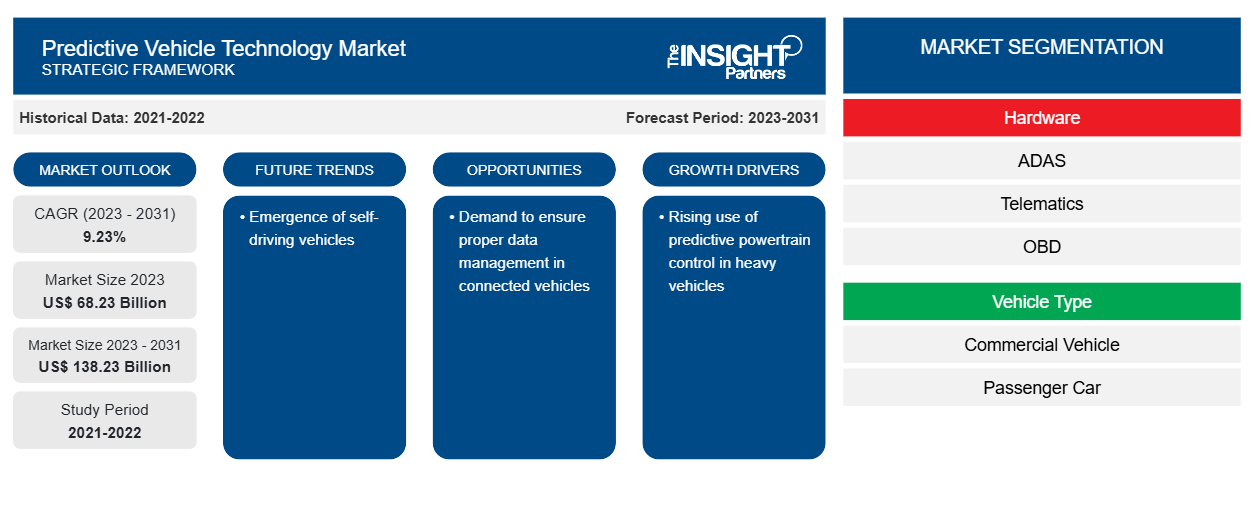Se proyecta que el tamaño del mercado de tecnología predictiva para vehículos alcance los 138,23 mil millones de dólares en 2031, frente a los 68,23 mil millones de dólares en 2023. Se espera que el mercado registre una CAGR del 9,23 % entre 2023 y 2031. Los beneficios del PPC han hecho que los fabricantes de automóviles, especialmente los fabricantes de vehículos comerciales pesados, integren el PPC en sus vehículos. El PPC se puede instalar en casi todos los tipos de camiones y vehículos pesados.
Análisis del mercado de tecnología predictiva para vehículos
Los principales actores en el ecosistema del mercado global de tecnología predictiva para vehículos incluyen proveedores de tecnología, proveedores de componentes, OEM y un segmento de usuarios finales de la industria automotriz. Los proveedores de tecnología ofrecen IA, ML y tecnología predictiva a los fabricantes de automóviles para integrar esta tecnología en sistemas como ADAS , OBD, telemática, V2X y más. Los fabricantes de componentes de este sistema mencionado incluyen sensores, cámaras, pantallas y más. Posteriormente, el producto del sistema integrado con la tecnología se instala en el vehículo para brindar una experiencia sin complicaciones al usuario al garantizar la seguridad tanto del conductor como del pasajero. Un canal de distribución que consta de OEM proporciona el producto final terminado a la categoría de usuarios finales. Tanto los automóviles de pasajeros como los vehículos comerciales utilizan tecnología predictiva y productos terminados integrados en sus vehículos. La tecnología predictiva para automóviles encuentra su aplicación en todo tipo de vehículos, incluidos automóviles, furgonetas, SUV y camiones.
Descripción general del mercado de tecnología predictiva para vehículos
En la actualidad, la industria automotriz está experimentando una incorporación significativa de varias tecnologías avanzadas en los automóviles para mejorar la seguridad y la eficiencia de los ocupantes. Los fabricantes de automóviles están aprovechando la inteligencia artificial (IA) y el aprendizaje automático (ML) para comprender los patrones y tendencias del conductor y mejorar la seguridad del vehículo. Ambas tecnologías están listas para convertirse en una parte vital de los próximos vehículos y la industria automotriz . En la carrera por los automóviles conectados y los vehículos autónomos, las tecnologías predictivas de vehículos están ganando aceptación entre todos los tipos de automóviles, lo que ofrece una comodidad notable para el conductor y los pasajeros. Por lo tanto, los fabricantes de automóviles se están concentrando en adoptar dispositivos conectados e IoT en vehículos que admitan comandos de voz. La integración de IoT en automóviles conectados es el próximo gran desarrollo digital que persiste en la industria automotriz. Este hecho dará como resultado otra revolución a través de la introducción de vehículos autónomos. Los automóviles autónomos incluyen un sistema de gestión de sensores que hace posible y hace realidad la comunicación de vehículo a vehículo mediante IoT. Se proyecta que los factores antes mencionados de los automóviles conectados contribuirán al uso de tecnología predictiva mediante la introducción de un sistema predictivo de prevención de colisiones, un sistema de mantenimiento predictivo y más.
Personalice este informe según sus necesidades
Obtendrá personalización en cualquier informe, sin cargo, incluidas partes de este informe o análisis a nivel de país, paquete de datos de Excel, así como también grandes ofertas y descuentos para empresas emergentes y universidades.
-
Obtenga las principales tendencias clave del mercado de este informe.Esta muestra GRATUITA incluirá análisis de datos, desde tendencias del mercado hasta estimaciones y pronósticos.
Factores impulsores y oportunidades del mercado de la tecnología predictiva para vehículos
Aumento del uso del control predictivo del tren motriz en vehículos pesados
El control predictivo del tren motriz (PPC) llegó hace unos años para ganar impulso en los tiempos actuales. La adopción del PPC ayuda a reducir el consumo de combustible hasta en un 5% en el tráfico de larga distancia. Se trata de un sistema de control de crucero distinto que ahorra recursos monetarios mediante predicciones inteligentes. El PPC utiliza mapas 3D y datos GPS para escanear una carretera por delante. Más tarde, el sistema ajusta automáticamente la velocidad mientras se desplaza en consecuencia. Las mejoras en la modernización del PPC se adaptan bien a los servicios telemáticos de FleetBoard, ya que estos ya se utilizan en camiones. Los fabricantes de camiones pesados se están acercando a unidades de negocio complementarias para mejorar su cartera de productos y adquirir experiencia adicional en las tendencias del PPC. Por ejemplo, la tecnología PPC de Mercedes-Benz está disponible para su modernización en Actros, Arcos y Antos por parte de socios de Mercedes-Benz en toda Europa. El PPC en Mercedes-Benz ha pedido un promedio del 64% de los vehículos pesados en viajes de larga distancia. Se prevé que la creciente demanda de vehículos comerciales pesados aumente la adopción de tecnología predictiva en vehículos pesados.
Exigencia de garantizar una gestión adecuada de los datos en los vehículos conectados
La principal oportunidad que se busca en el ámbito de los coches conectados es la gestión de datos. Los coches conectados están transmitiendo enormes cantidades de datos a la nube y, por tanto, para utilizar una enorme cantidad de datos, la necesidad de análisis predictivos y de análisis de datos está aumentando. La prevención predictiva de colisiones, el mantenimiento predictivo, el marketing de automoción, el marketing de automoción y la gestión de datos de los vehículos conectados son algunos de los conceptos en auge responsables del crecimiento del mercado. Otra característica es el impulso del uso de la tecnología predictiva en los vehículos. Nissan ha desarrollado un sistema de prevención predictiva de colisiones con la ayuda de big data, sensores avanzados y conectividad de vehículo a vehículo. Este sistema nos permite juzgar la distancia y la velocidad del vehículo que va delante de un coche y de los dos vehículos que lo preceden. Además, se enviará un vídeo y una señal audible al conductor en caso de cualquier comportamiento inusual. Por tanto, con el enorme beneficio de un sistema de prevención predictiva de colisiones, la industria del automóvil podría ser testigo de un sistema de prevención de colisiones sofisticado y eficaz basado en el comportamiento predictivo del conductor, ya que los desarrolladores están trabajando para crear aplicaciones que mejoren la comunicación entre los vehículos conectados.
Análisis de segmentación del informe del mercado de tecnología predictiva para vehículos
Los segmentos clave que contribuyeron a la derivación del análisis del mercado de tecnología de vehículos predictivos son el hardware, el tipo de vehículo y la aplicación.
- En función del hardware, el mercado se ha dividido en ADAS, telemática y OBD. El segmento de carros de golf tuvo una mayor participación de mercado en 2023.
- Según el tipo de vehículo, el mercado de tecnología predictiva para vehículos se segmenta en vehículos comerciales y turismos. El segmento de turismos tuvo la mayor participación del mercado en 2023.
- Según la aplicación, el mercado de tecnología predictiva para vehículos se segmenta en alertas proactivas, seguridad y protección. El segmento de seguridad y protección tuvo la mayor participación del mercado en 2023.
Análisis del mercado de tecnología predictiva para vehículos por geografía
El alcance geográfico del informe del mercado de tecnología de vehículos predictivos se divide principalmente en cinco regiones: América del Norte, Europa, Asia Pacífico, Medio Oriente y África, y América del Sur.
Estados Unidos, Canadá y México son las principales economías de América del Norte. Debido a los mayores avances tecnológicos, la región de América del Norte siguió siendo un mercado competitivo, ya que el aumento de la población atrajo varios desarrollos tecnológicos debido a su alto poder adquisitivo. Con el paso de los años, los vehículos se han convertido en algo más parecido a computadoras sobre ruedas, lo que significa que los técnicos de taller modernos solo pueden hacer su trabajo con una herramienta analítica predictiva profesional. El mantenimiento predictivo permite al fabricante de automóviles reparar los problemas en cualquier pieza del automóvil antes de que se rompa. El uso del mantenimiento predictivo permite a los fabricantes cambiar el proceso de fabricación y deshacerse del problema para los productos futuros. Como la región está muy avanzada en términos de tecnología, varias empresas están integrando herramientas de mantenimiento predictivo en sus vehículos comerciales y de pasajeros.
Perspectivas regionales del mercado de tecnología predictiva para vehículos
Los analistas de Insight Partners explicaron en detalle las tendencias y los factores regionales que influyen en el mercado de tecnología predictiva para vehículos durante el período de pronóstico. Esta sección también analiza los segmentos y la geografía del mercado de tecnología predictiva para vehículos en América del Norte, Europa, Asia Pacífico, Oriente Medio y África, y América del Sur y Central.

- Obtenga datos regionales específicos para el mercado de tecnología predictiva de vehículos
Alcance del informe de mercado sobre tecnología predictiva de vehículos
| Atributo del informe | Detalles |
|---|---|
| Tamaño del mercado en 2023 | US$ 68,23 mil millones |
| Tamaño del mercado en 2031 | US$ 138,23 mil millones |
| CAGR global (2023 - 2031) | 9,23% |
| Datos históricos | 2021-2022 |
| Período de pronóstico | 2023-2031 |
| Segmentos cubiertos |
Por hardware
|
| Regiones y países cubiertos |
América del norte
|
| Líderes del mercado y perfiles de empresas clave |
|
Densidad de actores del mercado de tecnología predictiva para vehículos: comprensión de su impacto en la dinámica empresarial
El mercado de tecnología predictiva para vehículos está creciendo rápidamente, impulsado por la creciente demanda de los usuarios finales debido a factores como la evolución de las preferencias de los consumidores, los avances tecnológicos y una mayor conciencia de los beneficios del producto. A medida que aumenta la demanda, las empresas amplían sus ofertas, innovan para satisfacer las necesidades de los consumidores y aprovechan las tendencias emergentes, lo que impulsa aún más el crecimiento del mercado.
La densidad de actores del mercado se refiere a la distribución de las empresas o firmas que operan dentro de un mercado o industria en particular. Indica cuántos competidores (actores del mercado) están presentes en un espacio de mercado determinado en relación con su tamaño o valor total de mercado.
Las principales empresas que operan en el mercado de tecnología predictiva para vehículos son:
- Compañía AISIN SEIKI
- Limitado.
- PLC Aptiv
- Traffilog Ltd.
- Continental AG
Descargo de responsabilidad : Las empresas enumeradas anteriormente no están clasificadas en ningún orden particular.

- Obtenga una descripción general de los principales actores clave del mercado de tecnología predictiva de vehículos
Noticias y desarrollos recientes del mercado de tecnología predictiva para vehículos
El mercado de tecnología predictiva para vehículos se evalúa mediante la recopilación de datos cualitativos y cuantitativos posteriores a la investigación primaria y secundaria, que incluye publicaciones corporativas importantes, datos de asociaciones y bases de datos. A continuación, se incluye una lista de los avances en el mercado de tecnología predictiva para vehículos y las estrategias:
- En noviembre de 2023, la ciudad de Nueva Orleans anunció que utilizará la tecnología de Samsara Inc., pionera de Connected Operations™ Cloud, para mejorar la seguridad, la eficiencia y la sostenibilidad de las operaciones de la flota de la ciudad en 41 departamentos, incluidos el Departamento de Policía de Nueva Orleans (NOPD), el Departamento de Bomberos de Nueva Orleans (NOFD), el Departamento de Obras Públicas (DPW), la División de Cumplimiento de Códigos, el Departamento de Parques y Vías Públicas (PPW), el Departamento de Saneamiento y más. La ciudad está invirtiendo $75 millones en su flota y considera que la asociación tecnológica con Samsara es fundamental para el mantenimiento y la protección de sus vehículos. (Fuente: Samara Inc, comunicado de prensa/sitio web de la empresa/boletín informativo)
- En septiembre de 2023, M Group Services Plant & Fleet Solutions (MGSPFS), la empresa operativa de gestión de flotas del proveedor líder de servicios de infraestructura esencial M Group Services, ha estado trabajando con Samsara, el pionero de Connected Operations™ Cloud, y el proveedor de soluciones de seguridad para flotas con sede en el Reino Unido, Motormax, para ofrecer la próxima generación de sistemas de seguridad en vehículos para proteger a los conductores, los usuarios de la carretera y los ciudadanos. (Fuente: M Group Services Plant & Fleet Solutions, comunicado de prensa/sitio web de la empresa/boletín informativo)
Cobertura y entregables
El informe “Tamaño y pronóstico del mercado de tecnología predictiva de vehículos (2021-2031)” proporciona un análisis detallado del mercado que cubre las siguientes áreas:
- Tamaño del mercado y pronóstico a nivel global, regional y nacional para todos los segmentos clave del mercado cubiertos bajo el alcance
- Dinámica del mercado, como impulsores, restricciones y oportunidades clave
- Principales tendencias futuras
- Análisis detallado de las cinco fuerzas de Porter
- Análisis del mercado global y regional que cubre las tendencias clave del mercado, los principales actores, las regulaciones y los desarrollos recientes del mercado.
- Análisis del panorama de la industria y de la competencia que abarca la concentración del mercado, el análisis de mapas de calor, los actores destacados y los desarrollos recientes
- Perfiles de empresas detallados con análisis FODA
- Análisis histórico (2 años), año base, pronóstico (7 años) con CAGR
- Análisis PEST y FODA
- Tamaño del mercado, valor/volumen: global, regional y nacional
- Industria y panorama competitivo
- Conjunto de datos de Excel
Informes recientes
Informes relacionados
Testimonios
Razón para comprar
- Toma de decisiones informada
- Comprensión de la dinámica del mercado
- Análisis competitivo
- Información sobre clientes
- Pronósticos del mercado
- Mitigación de riesgos
- Planificación estratégica
- Justificación de la inversión
- Identificación de mercados emergentes
- Mejora de las estrategias de marketing
- Impulso de la eficiencia operativa
- Alineación con las tendencias regulatorias























 Obtenga una muestra gratuita para - Mercado de tecnología predictiva de vehículos
Obtenga una muestra gratuita para - Mercado de tecnología predictiva de vehículos